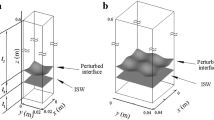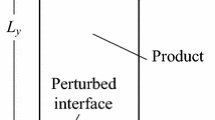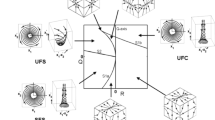Abstract
The instabilities of a three-dimensional sinusoidally premixed flame induced by an incident shock wave with Mach = 1.7 and its reshock waves were studied by using the Navier–Stokes (NS) equations with a single-step chemical reaction and a high resolution, 9th-order weighted essentially non-oscillatory scheme. The computational results were validated by the grid independence test and the experimental results in the literature. The computational results show that after the passage of incident shock wave the flame interface develops in symmetric structure accompanied by large-scale transverse vortex structures. After the interactions by successive reshock waves, the flame interface is gradually destabilized and broken up, and the large-scale vortex structures are gradually transformed into small-scale vortex structures. The small-scale vortices tend to be isotropic later. The results also reveal that the evolution of the flame interface is affected by both mixing process and chemical reaction. In order to identify the relationship between the mixing and the chemical reaction, a dimensionless parameter, \(\eta \), that is defined as the ratio of mixing time scale to chemical reaction time scale, is introduced. It is found that at each interaction stage the effect of chemical reaction is enhanced with time. The enhanced effect of chemical reaction at the interaction stage by incident shock wave is greater than that at the interaction stages by reshock waves. The result suggests that the parameter \(\eta \) can reasonably character the features of flame interface development induced by the multiple shock waves.













Similar content being viewed by others
References
Marble, F.E., Sonneborn, G., Pun, C.S.J., et al.: Physic conditions in circumstellar gas surrounding SN 1987A 12 years after outburst. Astrophys. J. 545, 390–398 (2000). doi:10.1086/317809
Oran, E.S., Gamezo, V.N.: origins of the deflagration-to-detonation transition in gas-phase combustion. Combust. Flame 148, 4–47 (2007). doi:10.1016/j.combustflame.2006.07.010
Yang, J., Kubota, T., Zukoski, E.E.: Applications of shock-induced mixing to supersonic combustion. AIAA Paper 31, 854–862 (1993). doi:10.2514/3.11696
Markstein, G.H.: A shock-tube study of flame front-pressure wave interaction. In: 6th Symposium (International) on Combustion. The Combustion Institute, Pittsburgh, USA, 387–398 (1957). doi:10.1016/S0082-0784(57)80054-X
Ton, V.T., Karagozian, A.R., Marble, F.F., et al.: Numerical simulations of high speed chemically reactive flow. Theoret. Comput. Fluid Dyn. 6, 161–179 (1994). doi:10.1007/BF00312347
Ju, Y., Shimano, A., Inoue, O.: Vorticity generation and flame distortion induced by shock flame interaction. In: 27th Symposium (International) on Combustion. The Combustion Institute, Pittsburgh, USA, 735–741 (1998). doi:10.1016/S0082-0784(98)80467-0
Zhu, Y.J., Dong, G., Liu, Y.X., et al.: A numerical study on shock induced distortion, mixing and combustion of flame. Explos. Shock Waves 33, 430–437 (2013). doi:10.11883/1001-1455(2013)04-0430-08
Zhu, Y.J., Dong, G., Liu, Y.X., et al.: Three-dimensional numerical simulations of spherical flame evolutions in shock and reshock accelerate flows. Combust. Sci. Technol. 185, 1415–1440 (2013) (in Chinese). doi:10.1080/00102202.2013.798656
Khokhlov, A.M., Oran, E.S., Chtchelkanova, A.Y.: Interaction of a shock with a sinusoidally perturbed flame. Combust. Flame 117, 99–116 (1999). doi:10.1016/S0010-2180(98)00090-X
Jiang, H., Dong, G., Chen, X., et al.: Numerical simulations of the process of multiple shock–flame interactions. Acta Mech. Sin. 32, 659–669 (2016). doi:10.1007/s10409-015-0552-0
Jiang, H., Dong, G., Chen, X., et al.: A parameterization of the Richtmyer–Meshkov instability on a premixed flame interface induced by the successive passages of shock waves. Combust. Flame 169, 229–241 (2016). doi:10.1016/j.combustflame.2016.04.021
Massa, L., Jha, P.: Linear analysis of the Richtmyer–Meshkov instability in shock–flame interactions. Phys. Fluids 24, 056101 (2012). doi:10.1063/1.4719153
Balsara, D.S., Shu, C.W.: Monotonicity preserving weighted essentially non-oscillatory schemes with increasingly high order of accuracy. J. Comput. Phys. 160, 405–452 (2000). doi:10.1006/jcph.2000.6443
Thomas, G.O., Bambrey, R., Brown, C.: Experimental observations of flame acceleration and transition to detonation following shock–flame interaction. Combust. Theory Modell. 5, 573–594 (2001). doi:10.1088/1364-7830/5/4/304
Leinov, E., Malamud, G., Elz, Y., et al.: Experimental and numerical investigation of the Richtmyer–Meshkov instability under re-shock conditions. J. Fluid Mech. 626, 449–475 (2009). doi:10.1017/S0022112009005904
Ukai, S., Balakrishnan, K., Menon, S.: Growth rate predictions of single- and multi-mode Richtmyer–Meshkov instability with reshock. Shock Waves 21, 533–546 (2011). doi:10.1007/s00193-011-0332-0
Zhou, J., Adrian, R.J., Balachandar, S., et al.: Mechanisms for generating coherent packets of hairpin vortices in channel flow. J. Fluid Mech. 387, 353–396 (1999). doi:10.1017/S002211209900467X
Warnatz, J., Maas, U., Dibble, R.W.: Combustion: Physical and Chemical Fundamentals, Modelling and Simulation, Experiments, Pollutant Formation, 4th edn. Springer-Verlag, Berlin (2006)
Acknowledgements
The work was supported by the National Natural Science Foundation of China (Grant 11372140).
Author information
Authors and Affiliations
Corresponding author
Rights and permissions
About this article
Cite this article
Chen, X., Dong, G. & Jiang, H. A three-dimensional numerical study on instability of sinusoidal flame induced by multiple shock waves. Acta Mech. Sin. 33, 316–326 (2017). https://doi.org/10.1007/s10409-017-0639-x
Received:
Revised:
Accepted:
Published:
Issue Date:
DOI: https://doi.org/10.1007/s10409-017-0639-x




